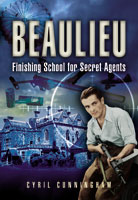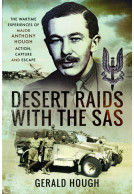Commando Tactics (Hardback)
The Second World War
Imprint: Pen & Sword Military
Pages: 224
ISBN: 9781848840744
Published: 15th November 2010
(click here for international delivery rates)
Order within the next 2 hours, 51 minutes to get your order processed the next working day!
Need a currency converter? Check XE.com for live rates
| Other formats available - Buy the Hardback and get the eBook for free! | Price |
|---|---|
| Commando Tactics ePub (25.7 MB) Add to Basket | £6.99 |
British commandos are among the most celebrated soldiers of the Second World War. Their daring, ingenuity and bravery have given rise to an almost legendary reputation that makes it difficult to appreciate fully their role and their true value as fighting men. Stephen Bull, in this in-depth study of commando tactics and history, seeks to dispel the myths and the misunderstandings that surround them, and he places these elite troops of 70 years ago in the context of their times. He also demonstrates that the idea of the commando took time to develop – and that commando operations were far from always successful. Commando tactics – amphibious, mountain, close quarter – were forged through the often-painful experience of raids and combined operations. And commando tactics and organization remained in a state of flux throughout the war as new situations and challenges arose. Stephen Bull's vivid account will be essential reading for anyone who is interested in commando fighting techniques and the early history of special forces.
Dr Stephen Bull is currently Curator of Military History and Archaeology for Lancashire Museums. He has previously worked at the National Army Museum, and for the BBC in London. He is the author of more than twenty military and historical titles published in Europe and the US, and he has appeared in the TV series Battlefield Detectives. Among his many publications are An Historical Guide to Arms and Armour, Volunteer! The Lancashire Rifle Volunteers 1859-1885, Brassey's History of Uniforms: World War One British Army, World War I Trench Warfare, Encyclopedia of Military Technology and Innovation, World War II Infantry Tactics and World War II Jungle Warfare Tactics.
An in-depth study of commando tactics training and actions that these elite troops took part in. Raised at Churchill's request these units took part in some of the most hard fought battles of world war 2.
WW2 Connection.com
70 years ago British Commandos were among the most celebrated soldiers of the second world war. This excellent book covers the creation of the force and how they developed and experimented with all aspects of the new commando warfare ,including amphibious assault, mountain and close quarter combat. A really interesting and at times vivid account of the early history of special forces techniques.
The British Commandos were one of the most famous Special Forces units of the Second World War, even though the Army Commandos were disbanded almost immediately at the end of the conflict.
History of War Website
Bull asks a series of questions about the Commandos - how were they selected, how were they trained, how were they used and how did that change over time being the most important. The nature of the unit changed over time, from its formation in the aftermath of the defeat of France, when it was used for small scale raiding, to the invasion of Normandy, when two full brigades of Commandos were used.
There are some interesting sections on Commando training, the role played by Fairbairn and Sykes and the training in remote parts of Scotland. Many of the key Commando raids and missions are also studied. By looking at these wider questions, Bull has produced a very valuable history of the Commandos, looking beyond the glamour of their raids to paint a wider picture of this elite unit.
As Stephen Bull quite rightly states in this book, the word ‘Commando‘ has become common currency for all kinds of special forces operations.
Daly History Blog
The ‘commando’ concept originated from the Boer War, when Dutch-descended ‘Kommando‘ units caused havoc for much larger British units in the South African veldt. Winston Churchill, who was a war correspondent at the time, recalled the idea in 1940. At the outset of the Second World War, Britain didn’t really ‘do’ special forces. The Commando’s were formed in 1940, partly by initiative amongst the armed forces, but also spurred on by characteristic notes that flourished from Winston Churchill demmanding instant action. The idea was that while Britain was unable to stike back at the enemy in a conventional manner, small groups of nimble special forces could inflict an impact on occupied Europe out of all proportion to their size.
Commando’s made their presence felt on the Lofoten Raids in Norway; at St Nazaire and Dieppe; on D-Day and in Siciliy and Italy. Strictly speaking the British Army C0mmandos were formed from volunteers from Army units, but the Royal Marines also formed their own Commando units later in the war. The Parachute Regiment was formed from No 2 Commando in 1940, and the SAS and SBS were formed by formed Commando officers. Thus it could be argued that the Commando’s formed their embryo for modern British special forces. Ironically, whilst the Royal Marine Commandos, Parachute Regiment, SAS and SBS still exist, the Army Commandos were disbanded soon after the war.
The title of this book focuses on tactics, but Bull goes much further by writing about the wider history of the Commandos, and the impact that the development of the Commando’s has had on British military ethos and development, the effects of which can still be seen today. But the real strength of this book is in the description of the making of a Commando – what went into selecting and training the men, the development of tactics and equipment, and how mistakes were made and lessons were learnt until a well-honed concept was arrived at. The ‘small, heavily armed but highly mobile’ approach has become widespread amongst all special forces to this day. There is also much in the selection and training that will be familiar to anyone who has read Bravo Two Zero or the million and one other SAS memoirs.
This book adds considerably to the historiography of British special forces during the Second World War. It is an interesting read in its own right, but it also stands up extremely well as an in-depth military study. It contains some fascinating biographies of leading Commandos, and some useful eyewitness accounts. But the real piece de resitance is the inclusion of contemporary documents, such as details of Commando clothing and equipment, the establishment and armanent of Commando units, and a booklet describing Commando Battle Drill.
In this in-depth study of commando tactics and history, the author examines the myths and the misunderstandings that surround them, and he places these troops in the context of their times. He also demonstrates that the idea of the commando took time to develop, and that they were sometimes far from successful.
Britain at War
This in depth study of commando tactics and history, seeks to dispel the myths and the misunderstandings that surround them, placing these elite troops of 70 years ago in the context of their times. This vivid account is essential reading for anyone interested in commando fighting techniques and the early history of special forces.
reenacting ww2
An excellent introduction to the formation of the British commandos in WW2 - a field of warfare where Britain led the way. The book maintains a good balance between narrative and analysis, and is readily accessible to the general reader as well as those with a more specialist interest. Perhaps the illustrations might have been a little more inspiring but, overall, a very good publication.
Robert Widders Blog
About Stephen Bull
Dr Stephen Bull is currently Curator of Military History and Archaeology for Lancashire Museums. He has previously worked at the National Army Museum, and for the BBC in London. He is the author of more than twenty military and historical titles published in Europe and the US, and he has appeared in the TV series Battlefield Detectives. Among his many publications are An Historical Guide to Arms and Armour, Volunteer! The Lancashire Rifle Volunteers 1859-1885, Brassey's History of Uniforms: World War One British Army, World War I Trench Warfare, Encyclopedia of Military Technology and Innovation, World War II Infantry Tactics, World War II Jungle Warfare Tactics and Commando Tactics: The Second World War.

















